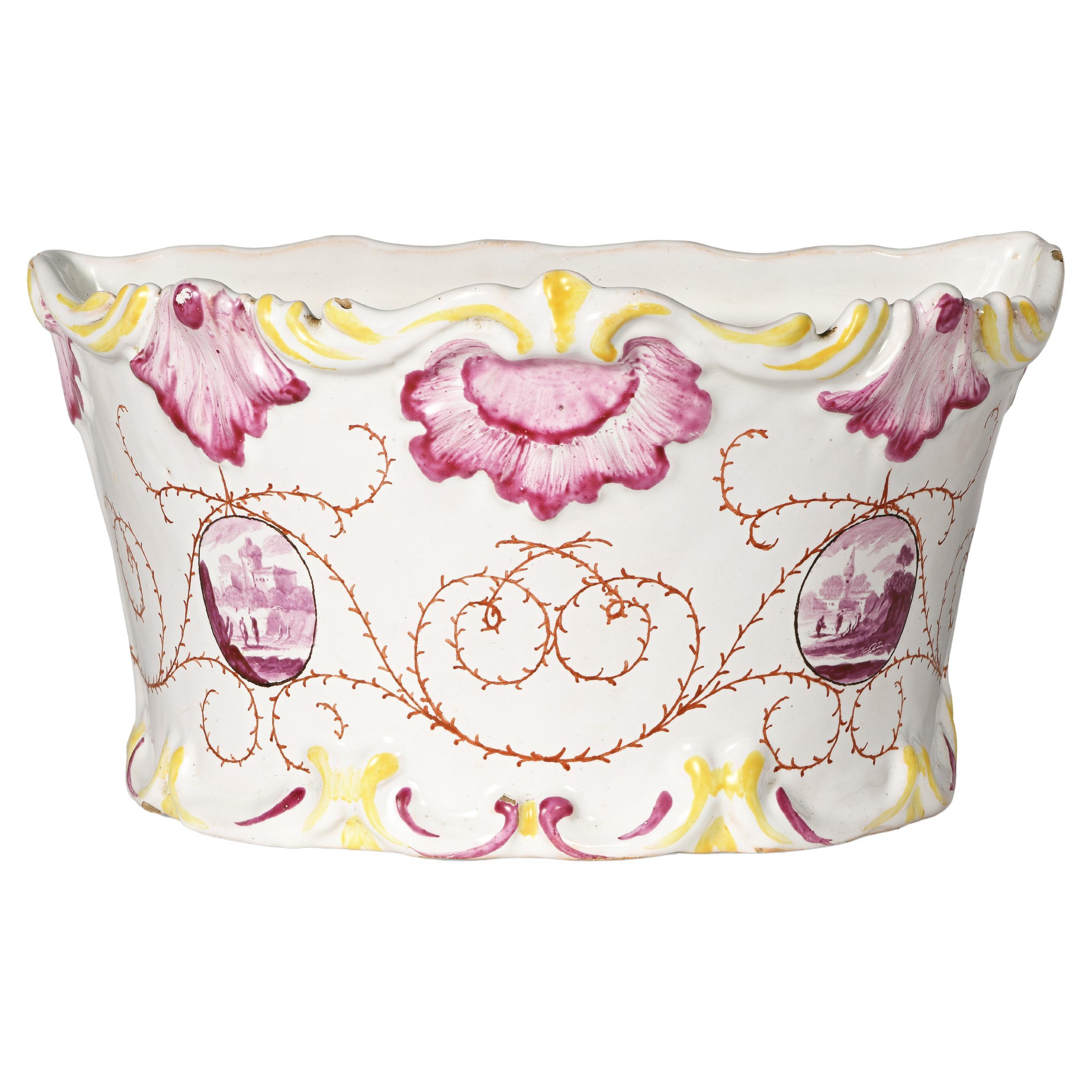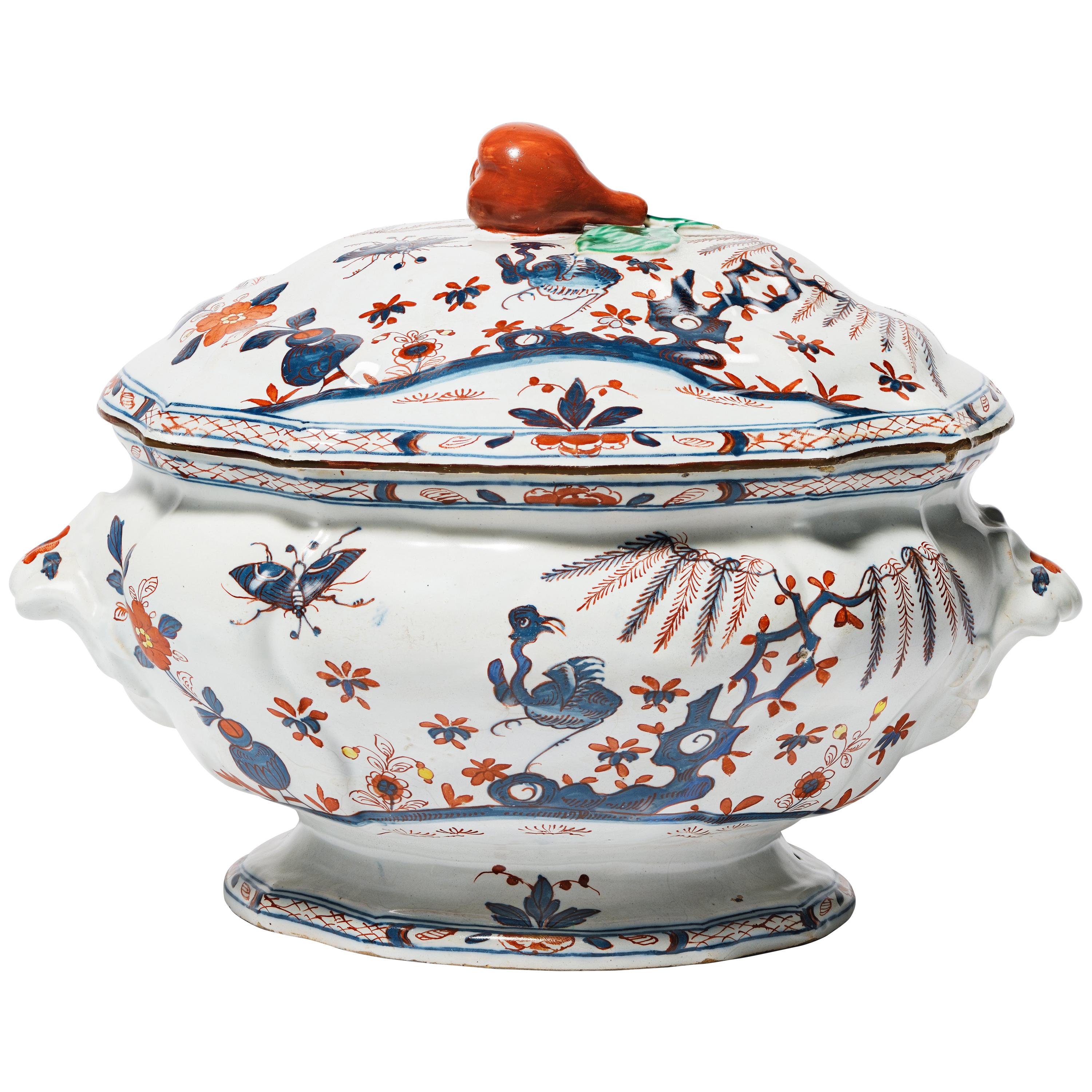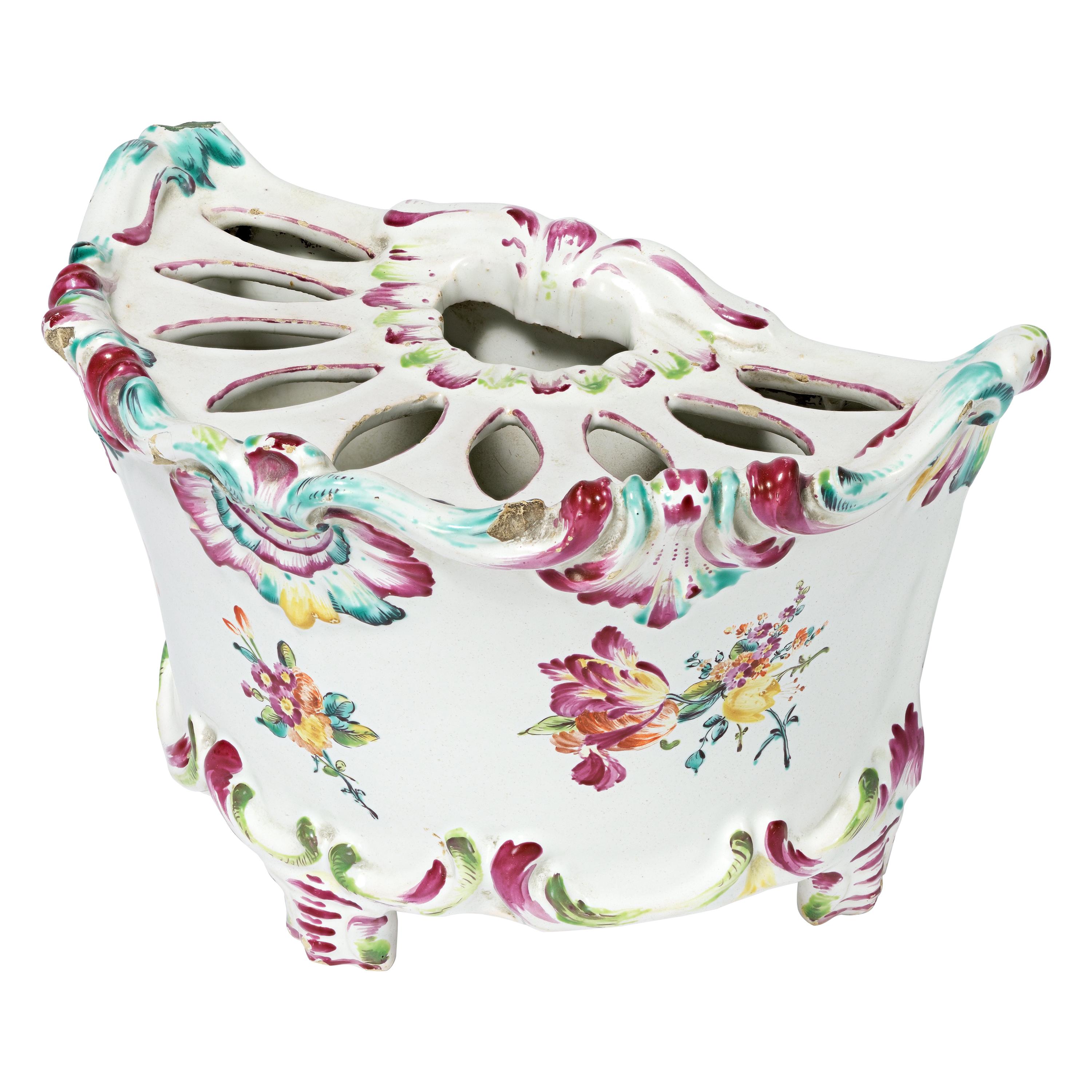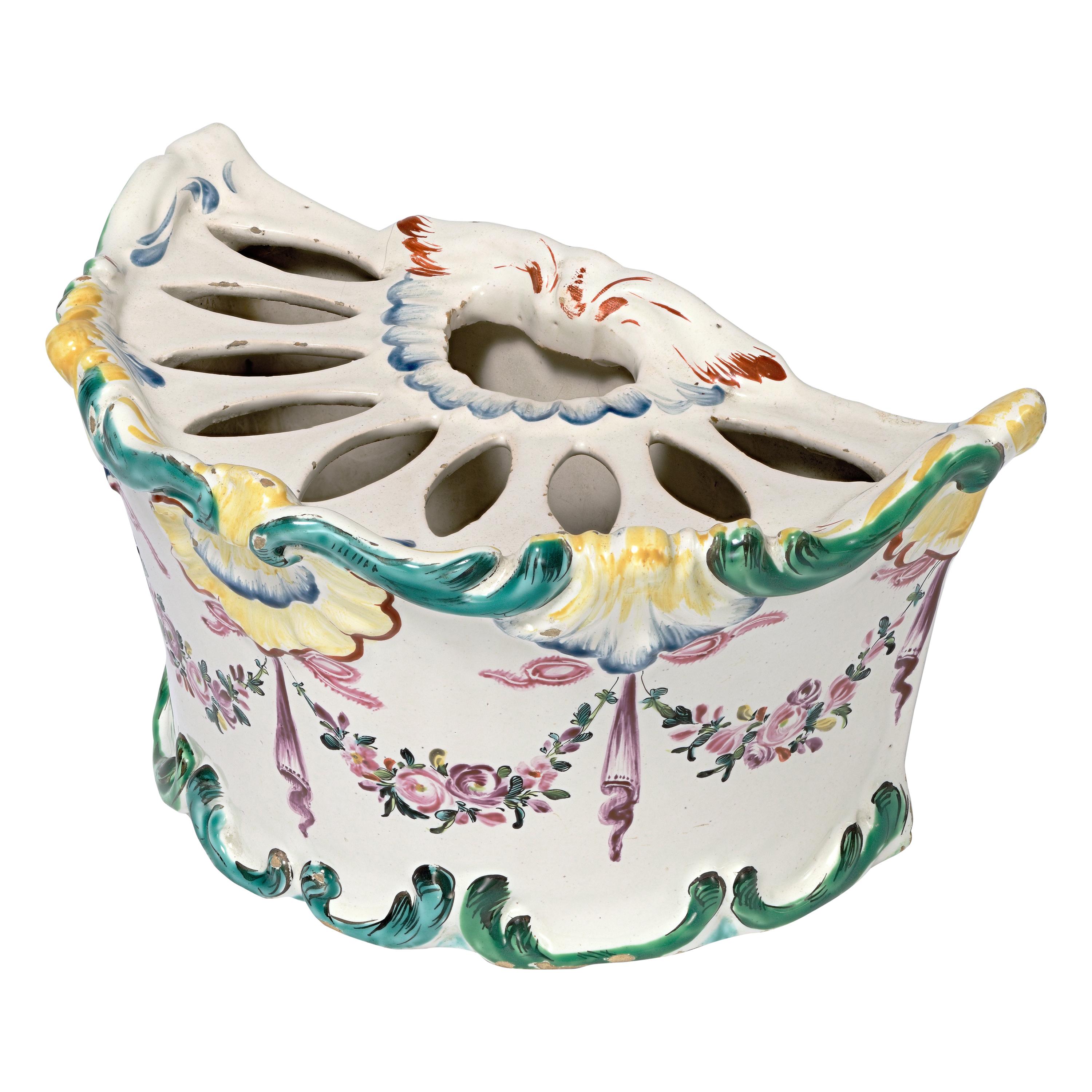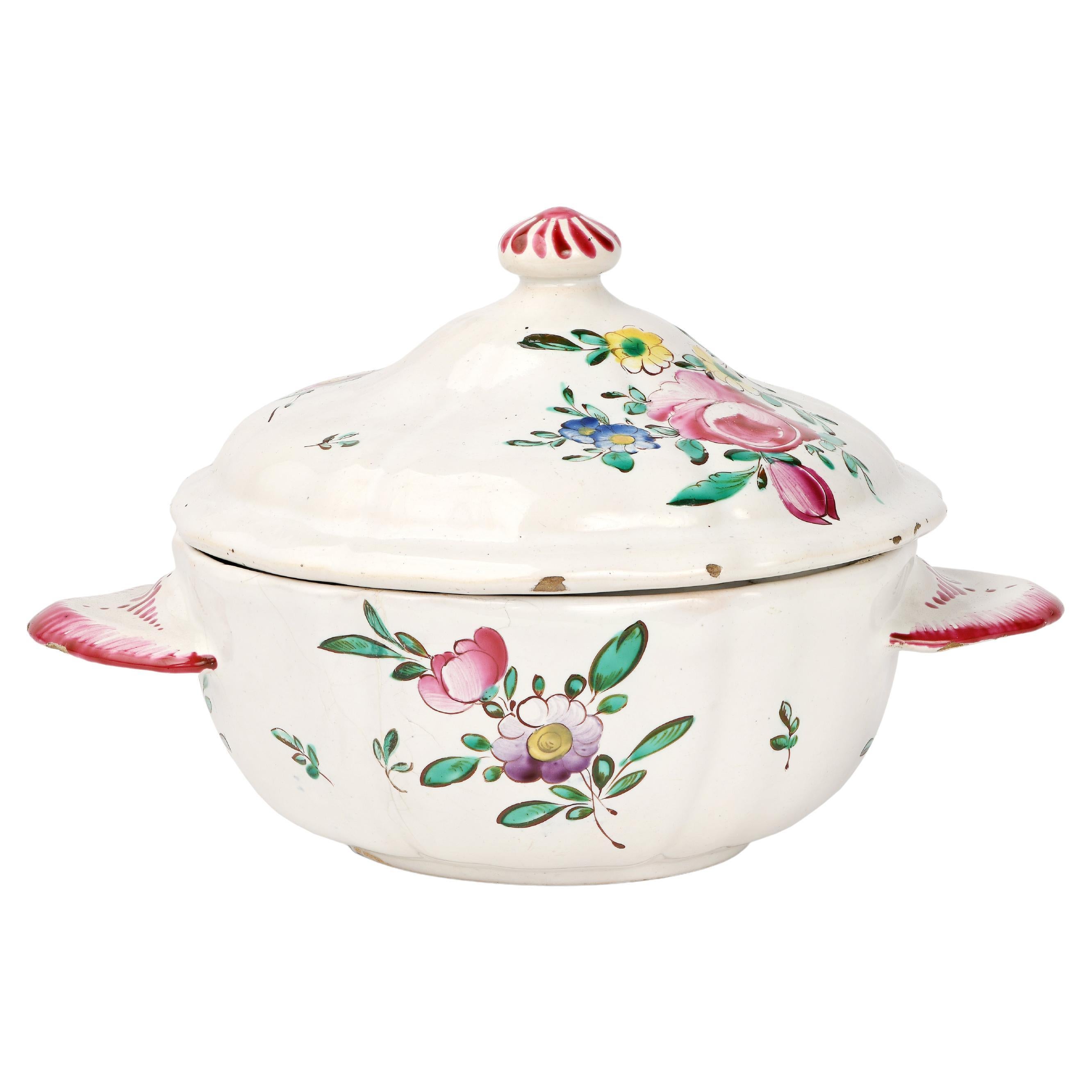Items Similar to 18th Century Italian Maiolica Dish Milano, circa 1770
Video Loading
Want more images or videos?
Request additional images or videos from the seller
1 of 18
18th Century Italian Maiolica Dish Milano, circa 1770
About the Item
Maiolica dish, "Famille Rose" and gold decoration
Felice Clerici factory
Milan, 1770-1780
8.93 in (22.27 cm) in diameter
lb 0.66 (kg 0.3)
State of conservation: perfect, except for slight chipping at the edges
The dish is rare example of a service produced by the factory of Felice Clerici (1710-1780) in Milan.
Felice Clerici had opened his own factory in Milan in 1745, inserting himself into the new European stylistic trend which saw Maiolica becoming a Fine product like porcelain. The Milanese entrepreneur worked in the early period with high fire furnaces, declaring only in 1759 that he had purchased "the secrets of the paintings by force of money," by which he meant he now could obtain colors with a greater chromatic range with a low fire.
The dish belonged to a particularly refined assortment, which, thanks to the lightly blue glaze and the skilful use of the palette, ought to give the impression of resembling completely the contemporary Chinese works.
The plate is a fund with an especially thin thickness, smooth edge and a barely detectable ring foot. Along the edge there is a thin orange and gold band with a chain of small spirals whereas along the brim there is a typical oriental decoration with peonies and chrysanthemums and minor florets. The flounce hosts a motif "in reserves" centered inside alternating flower and trellis motifs on pink and green backgrounds; among the other elements some flowers made in gold Stand out. In the center an oriental floral ornament is developed around a sturdy branch. On the back the "fraction" brand by Felice Clerici in black.
Raffella Ausenda, while cataloging a Maiolica in the same model as ours, conserved in the collections of the Museo di Arti Applicate del Castello in Milan (to which we refer for comparison), highlights that the ornamentation is directly inspired by Chinese porcelain from the Kang'hsi period known as "Famille Rose". The Clerici manufacture had in fact such a technical command of colors that it could perfectly imitate the oriental models even thanks to the aid of painters such as Giuseppe Sormani and Giacomo Facchetti who “painted with enamel in gold and silver colors. They imitate and accompany porcelain".
The recent publication, edited by the same scholar (R. Ausenda in J.V.G. Mallet and E.P. Sani, a cura di, Maiolica in Italy and Beyond. pp. 124-140), underlines how the rebirth of maiolica in northern Italy also sprang from the experiences of the Milanese factory of Pasquale Rubati. This factory, established in 1756, obtained very high quality products, even considered among the best of the time. In the study she remarks how the pieces produced in the factory so closely matched Chinese porcelain that they were often used to replace pieces needing substitution, as Rubati himself declares "... to be able to accompany the missing pieces of porcelain with maiolica without distinguishing one on the other hand, except transparency. " (R. Ausenda in J.V.G. Mallet and E.P. Sani, a cura di, Maiolica in Italy and Beyond,. pp. 124 140)
Many examples for comparison are kept in the main European museum collections including a famous tureen that bears the coat of arms of the Marquis Don Giovanni Olivera. This leads us to a certain chronological collocation of 1771, the year the emblem was registered in the Teresian heraldic codes. (Ausenda, R., a cura di, Musei e Gallerie di Milano. Museo d’Arti Applicate. Le ceramiche. Tomo secondo. Milano 2001, pp. 349, n. 335 and related bibliography). The tureen is kept in the Kunst und Gewerbe Museum in Hamburg (inv. 1882.276).
From the same De Olivera service comes a dish which was purchased from our gallery by MUDEC (Museum of Cultures of Milan) and which is currently exhibited as a work in the permanent collections of the exhibition Milano globale, il Mondo visto da qui (Global Milan, the World Seen from Here).
Bibliography:
R. Ausenda, a cura di, Musei e Gallerie di Milano. Museo d’Arti Applicate. Le ceramiche. Tomo secondo. Milano 2001, pp. 349, n. 335 e bibliografia relativa.
R. Ausenda, Hig-quality Maiolica in the Style of Porcellain: Experiments in northern Italian Maiolica in its productive final Years in J.V.G. Mallet and E.P. Sani, a cura di, Maiolica in Italy and Beyond,. pp. 124 140
R. Ausenda in, Milano globale, il Mondo visto da qui, sala 2, La nuova dimensione globale del continente asiatico, pp. 194-195.
- Dimensions:Height: 1.11 in (2.8 cm)Diameter: 8.77 in (22.27 cm)
- Style:Rococo (Of the Period)
- Materials and Techniques:Maiolica,Other
- Place of Origin:
- Period:1770-1779
- Date of Manufacture:circa 1770
- Condition:Wear consistent with age and use. Almost perfect, except for slight chipping at the edges.
- Seller Location:Milano, IT
- Reference Number:1stDibs: LU4352214025682
About the Seller
4.3
Vetted Seller
These experienced sellers undergo a comprehensive evaluation by our team of in-house experts.
Established in 1860
1stDibs seller since 2018
19 sales on 1stDibs
Typical response time: 4 hours
Associations
International Confederation of Art and Antique Dealers' Associations
- ShippingRetrieving quote...Ships From: Milano, Italy
- Return PolicyA return for this item may be initiated within 14 days of delivery.
More From This SellerView All
- 18th Century, Italian Maiolica Flower Pot, Pasquale Rubati, Milan, 1770 circaBy Pasquale RubatiLocated in Milano, ITMaiolica flower pot “a mezzaluna” decorated with trompe l’oeil Pasquale Rubati Factory Milan, 1770 circa It measures: 4.7 in (cm 12) X 5 in (...Category
Antique 1770s Italian Rococo Ceramics
MaterialsMaiolica
- Ancient Italian Maiolica Tureen Milano, 1770 circaBy Pasquale Rubati, Felice ClericiLocated in Milano, ITMaiolica tureen “allo struzzo” (ostrich decoration) Milan, Felice Clerici or Pasquale Rubati factory, circa 1750-1780 Measures: 9.25 in x 12.79 in x 10.23 in (cm 23.5 x cm 32.5 x cm 26) lb 4.78 (kg 2.17) State of conservation, a felûre consolidated inside with slight edge chipping restored. In Milan in the 18th century two Majolica warehouses were opened, the first, by Felice Clerici, in 1745, the second in 1756 by Pasquale Rubati. Traditionally this type of decoration has been attributed to the Pasquale Rubati factory. In reality the motif “allo struzzo”, one of the clearest examples of how the taste for chinoiserie met with considerable success during the 18th century, had been produced, in specimens of greater or lesser quality, by both Milanese manufactories. This Maiolica tureen has a swollen and ribbed oval bowl, rests on an extroflexed foot and shows stirrup handles. The tri-color ornament, in the typical tones of Japanese "Imari" decorations, shows an idealized oriental landscape that develops around a perforated rock and has a willow tree with long lance-shaped leaves framing the long-legged bird figure. The ornamentation is enhanced by decorative elements such as butterflies, small florets and a vase with a thin flowery stem. The lid is ribbed with a pear-shaped knob on top. The decoration was called in the Milanese manufactories "allo struzzo" (ostrich decoration) and this refers to the oriental figure Xian He or the crane, symbol of longevity, here losing its symbolic value. It is hypothesized that among some 16th century engravings...Category
Antique 1770s Italian Chinoiserie Ceramics
MaterialsMaiolica
- Ancient Pair of Italian Maiolica Dishes Milano, circa 1770By Felice ClericiLocated in Milano, ITTwo maiolica dishes, "Famille Rose" decoration Felice Clerici Factory Milan, 1770-1780 9.13 in (23.2 cm) each in diameter lb 1.32 (kg 0.6) State of conservation: perfect, except for...Category
Antique 1770s Italian Rococo Ceramics
MaterialsMaiolica
- Rococo Italian Maiolica Flower Pot Pasquale Rubati, Milano, 1770 circaBy Pasquale RubatiLocated in Milano, ITMaiolica flower pot “a mezzaluna” with support feet decorated with little bunches of flowers Pasquale Rubati Factory Milan, circa 1770 5.5 in X ...Category
Antique 1770s Italian Rococo Ceramics
MaterialsMaiolica
- Italian Maiolica Flower Pot Garlands of Flowers, P. Rubati, Milano, 1770 circaBy Pasquale RubatiLocated in Milano, ITMaiolica flower pot “a mezzaluna” decorated with garlands of flowers Pasquale Rubati Factory Milan, circa 1770 Measures: 4.7 in x 5 in x 8.8 in ...Category
Antique 1770s Italian Rococo Ceramics
MaterialsMaiolica
- Italian Maiolica Cup Ferretti Lodi, circa 1770 - 1780By Antonio FerrettiLocated in Milano, ITMaiolica puerperal cup Antonio Ferretti Manufacture Lodi, Circa 1770 - 1780 Maiolica polychrome decorated “a piccolo fuoco” (third fire). It measures: 4.3 x 6.8 x 5.3 in (11 x 17,5 x 13,5 cm) Weight: 0.78 lb (358 g) State of conservation: some closed pass-through fêlures on the cup, barely visible on the outside. Some use chips on the edge of the lid, two of which are more marked. From about the mid-sixteenth century, the puerperal soup tureen or puerperal cup became one of the most popular wedding gifts in central Italy. As an auspicious symbol, it replaced the birth table (“desco da parto”) which, on the occasion of high-ranking marriages, from the thirteenth century, had been painted by famous artists, especially in Tuscany. In France this same tureen is called "écuelle de mariée", as it is given to spouses as a sign of fertility. During the eighteenth century this custom spread even outside Italy to all social levels. Depending on availability and rank, it was made of different materials: precious metals, maiolica, porcelain, glass, pewter, etc. Beginning in the mid-twentieth century, the custom of this symbolic homage gradually disappeared, although famous designers such as Gio Ponti and Giuseppe Gariboldi, even as recently as the 1940s, revisited a model of a small puerperal soup bowl for the Ginori and, also in Italy in 1940, in a national competition for young potters, one of the themes of the test was indeed a modern model of a puerperal cup as an auspicious gift. This particular cup was also called a "service cup" or "puerperal vase" or "stuffed cup" - the windows were sealed with straw to prevent drafts of air for women in labor. In the eighteenth century the line of the puerpera cup was simplified, so much so that it took the form of a small tureen with two handles - the typical broth cup...Category
Antique 1770s Italian Rococo Ceramics
MaterialsMaiolica
You May Also Like
- A Deruta Maiolica Dish Early 16th CenturyLocated in Firenze, ITSHIPPING POLICY: No additional costs will be added to this order. Shipping costs will be totally covered by the seller (customs duties included). The centre painted with archaic de...Category
Antique 16th Century Italian Renaissance Ceramics
MaterialsMaiolica
- 16th Century Castelli Italian Maiolica Farnese alla turchina DishBy CastelliLocated in Fort Lauderdale, FLAn extraordinary azure maiolica dish in the Farnese service, made by Castelli d'Abuzzo between 1580 and 1589. In the peak of the High Renaissance, Cardinal Alessandro Farnese commissioned a dinner service from the Castelli maiolica...Category
Antique 16th Century Italian Renaissance Decorative Art
MaterialsMaiolica
- Late 18th Century Blue And White Glazed Faience Charger, circa 1770, DenmarkLocated in Haddonfield, NJA large Danish (or Northern German) faience charger from circa 1780 in blue and white flower decor. The decoration is inspired by, or actually exact copies of the contemporary Chine...Category
Antique Late 18th Century Danish Rococo Ceramics
MaterialsFaience
- A Large Italian Maiolica Charger, 19th CenturyLocated in CABA, ARMaiolica chargers are large, decorative ceramic plates that are part of the broader tradition of Maiolica pottery, a type of tin-glazed earthenware produced in Italy since the Renais...Category
Antique 19th Century Italian Renaissance Revival Ceramics
MaterialsCeramic
- English Pottery Slipware Baking Dish, 18th CenturyBy StaffordshireLocated in Gargrave, North YorkshireEnglish pottery slipware baking dish, late 18th century. The plain edged, brown glazed dish, trailed in creamy yellow slip, with a wriggled, trellis design, b...Category
Antique 1780s English Georgian Ceramics
MaterialsEarthenware
- Meissen Porcelain 18th Century Leaf Dish Hand Painted, circa 1770By Meissen PorcelainLocated in Katonah, NYThis large 18th century Meissen porcelain leaf form dish incorporates the prevailing artistic trends of the time. Rococo art was known for its emphasis on asymmetry and naturalistic ...Category
Antique Late 18th Century German Rococo Porcelain
MaterialsPorcelain
Recently Viewed
View AllMore Ways To Browse
Italian Silver 18th Century
18th Century Chinese Glass
Italian Fine Ceramics
Small Glass Dish
Green Glass Dish
Dish Stand
Italian 1770
Green Glass Ring
Black Glass Dish
Floral Dish
Oriental Ceramics
18th Century Firing Glass
Rococo 1770
Rococo Pink
Antique Style Silver Rings
Dish Service
Dish On Stand
Chinese Silver Dish
